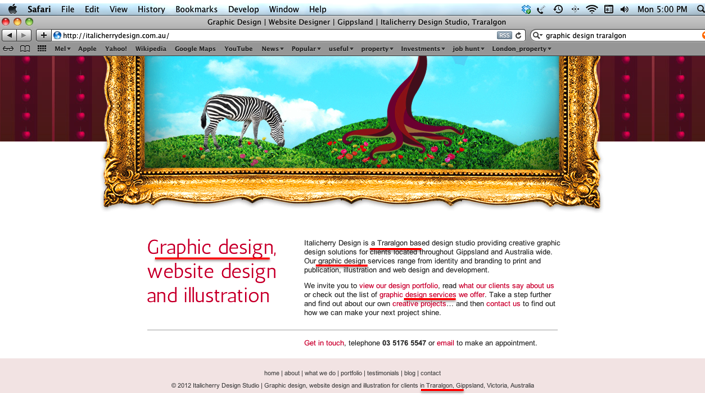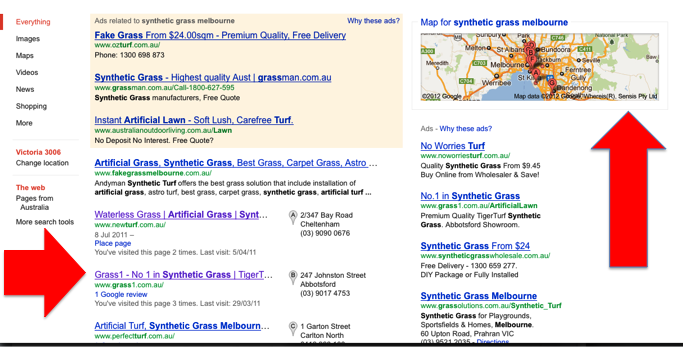 I’ve been working with a number of clients recently to successfully bring them targeted web traffic from their local area, so I thought it was timely to confirm the three different ways that your website can be found in local search results.
I’ve been working with a number of clients recently to successfully bring them targeted web traffic from their local area, so I thought it was timely to confirm the three different ways that your website can be found in local search results.
This information might not be new for you, but it’s a good time to check whether or not you’re covering all the bases with your current online marketing program.
Local search results are about quality, not quantity
When people search in Google for a business in their local area they are not only searching for “what”, but also for “where”.
The “what” is the main keyword that they use, and the “where” can be indicated by a city or suburb name, postcode or street address.
For local searches like these, there are three different ways that your website can get found in Google.
So if you’re targeting business from a specific geographic area around your business location, read on… and keep in mind that getting locally targeted web traffic is not always a numbers game. There might not be many people searching for your keywords in your local area, but those who are equate to quality web traffic because they are searching for what you have to offer, in the area where you offer it.
And the fact that they are adding the “where” to their search shows intent to use the products or services of the business that they select from those they find.
In this article I’ll use a case study of the website of one of my clients. The business is called Italicherry Design Studio and it is located in Traralgon (my home town!), a city of about 25,000 people found in Gippsland, Victoria.
1. Getting locally targeted web traffic from organic search results
The organic search results are the main results in the left hand column of the Search Engine Results Page (also known as the SERP).
If you’ve heard of Search Engine Optimisation (SEO), then broadly speaking it covers everything that you do to get your website to appear high up in the organic results.
The list of things that have an impact on your website’s SEO is long, but here are some key areas:
- The keywords that you use on your website and where you use them
- The number and quality of inbound links from other websites to your website
- The way your website is set up.
Let’s look at the first point: The keywords that you use on your website and where you use them.
The screen shot above shows a Google search for the keyword “graphic design traralgon” and the website that we’re looking at ranks in No.1 position out of about 150 websites that use this keyword in their web copy.
So how did we achieve this?
Admittedly web copywriting takes some skill in terms of selecting the right keywords and using them strategically (without overusing them) but it’s also not rocket science once you know the main principals.
The top (purple) line of text in the Search Results reads “Graphic Design | Website Design | Italicherry Design Studio, Traralgon”. (Note that only the first 69 characters or so of text appear in the search results, the rest is cut off, so aim to keep your Page Title around this length).
This text is the Page Title from the Home Page of the website. The image below shows where it appears on the website.
In the next image the keywords have been underlined to show where they have been used in the home page copy.
Where the words are pink, they have been used as link text to link to the page that is specifically about “graphic design services”.
As mentioned above, there are a lot of factors in addition to keywords that help your website rank high in Google. But the keywords are something that you can control so why not make sure you have used them effectively?
In terms of the other factors, the Italicherry Design website was built using WordPress and we used a plugin called the “All in One SEO Pack” to help optimise the site. The website has also been around for about two years and the owner has been building inbound links at every opportunity so both these factors add weight to the importance that Google gives it.
2. Getting locally targeted traffic from your Google Places listing
To get your business to show up in Google with a pointer on the map of the area where someone is searching for a local business, you need a listing in Google Places.
In the picture below, the map appears at the top of the right hand column, and the details relating to each pointer on the map appear near the top of the organic search results in the left hand column.
You can set up a Google Places listing at google.com/places
Your business might already be listed in Google Places but if you haven’t claimed the listing and added information it might not be complete (or might even include inaccurate or out-of-date information).
To see if your business is there, search for “your business name + suburb (or city)”.
If a listing comes up, click through to the “Place Page” and in the top right hand corner you’ll see either “Owner-verified listing” or “Claim this listing”.
To Claim the Listing click through and follow the steps.
Add as much information to your listing as you can, including photos and videos – reviews are helpful too. Here are Google’s tips for what to do with your listing:
Your Google Places listing is also really important in helping clients find your location on a mobile phone. As the number of searches via a mobile phone is increasing, therefore whether or not your business shows up in mobile searches is increasingly important.
3. Getting locally targeted traffic from Google AdWords Ads
The third way that your website can be found in Google when someone searches for a local business is via the Google AdWords programs.
Google AdWords ads appear in the yellow box at the top of the left hand column of the search results, and also in the thinner column on the right hand side.
With AdWords:
- You pick the target geographic area where you would like your ads to be shown*
- You set up a list of targeted keywords and your ad appears when someone searches for those target keywords from within your target area
- You only pay when someone clicks on your ad
- The amount you pay is based on an auction system, and is relative to how much the other advertisers are prepared to pay.
- You set the maximum amount of budget that are prepared to spend per day.
*AdWords ads be targeted specifically to a city, for example Melbourne, or if you add a suburb or city name they can be targeted to a specified radius around that place.
I’ll give more details on locally targeted Google AdWords ads in a future article but until then, if you need help with AdWords, please send me an email.
Got questions about how to increase your locally targeted web traffic? Please leave a comment and let me know.
Until next time
Melinda
PS – Not receiving the monthly Click Tips newsletter via email?
Sign up here to receive one email each month full of information about online marketing issues, feedback and experiences that are relevant to businesses just like yours.
PPS – Italicherry Design Studio create beautiful websites.
If you’re not happy with your current website, contact Wendy for a free review and recommendations for improving it and bringing it into line with your current branding.
About Melinda
Melinda aka Mel is a Google Partner, Google Ads & Consultant, Speaker and Trainer and co-owner of Click-Winning Content.
Mel provides results-driven services to organisations around the world and is committed to never using an acronym without explaining it first. She also likes greyhounds as pets, grand slam tennis, cracked pepper and Melbourne sunsets.
Please connect at the links below.





I have listed under google places and used to have a number pointer. recently (about a month ago) I updated some info. Now I only have a dot not a number so don’t appear in the listings unless someone hovers over my dot (not likely). Is this an obsure google thing that will fix itself once google runs some mystical update or is this something I can fix?
cheers
Janine